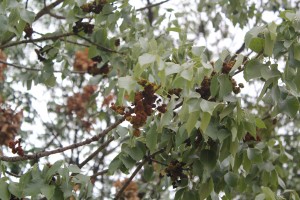
Ash flower gall is caused by a tiny mite, Eriophyes fraxiniflora. They appear to do little damage to ash trees and do not require treatment. The galls, originally green, turn reddish or brown in the fall.
Last week our forestry specialist sent the image shown here with questions about it’s possible cause. The culprit is a mite, often referred to as ash flower gall.
Like many pests of trees, ash flower galls may be more evident some years than others. The mite actually lives in the male flower parts of ash trees, and the gall is a distortion of those flower parts.
Because only the male flowers are attacked, tree health is not affected by infestations. However, many people consider the galls themselves unsightly, or worry that the tree looks unhealthy, especially when the leaves drop to the ground in the fall. Old galls turn reddish in the fall, and may remain on the tree for a year or more.
Once a gall has formed there is nothing that can be done short of pruning it from the tree. Sevin sprays, applied during summer, or possibly in the fall when mites are leaving the galls to overwinter under bud scales, may serve to reduce mite populations and next year’s galls–though this has not been tested in Texas to my knowledge. The best thing, in my opinion, is a few deep breathing exercises and counting your blessings.
As one smart-alec colleague of mine pointed out, if we ever get emerald ash borer in our state, we won’t have any more problems with ash flower galls… all the ashes will be gone. Yes, I’ll take the ash flower galls.
For more pictures of ash flower gall, click here.